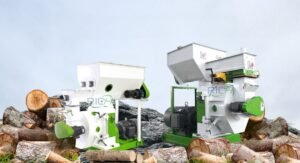
The organic fertilizer machine is composed of organic fertilizer fermentation turner, fertilizer pulverizer, mixer, organic fertilizer pellet making machine, organic fertilizer dryer, cooler, screening machine, storage bin, automatic packaging machine, belt conveyor, etc.
Processing livestock and poultry manure, straw rice husks, biogas sludge, kitchen waste, municipal waste and other organic materials into organic fertilizers can not only reduce environmental pollution but also turn waste into treasure.
1. Process flow of organic fertilizer pellet making machine line
- After the fermentation of the organic fertilizer raw materials is completed, it enters the organic fertilizer pulverizer and is pulverized into powder. The powder enters the organic fertilizer mixer and adds auxiliary materials for stirring.
After stirring evenly, it enters the organic fertilizer pellet making machine to make granules, and the produced granules are dried. The moisture of the particles is reduced to 10-20% in the machine, and then enters the cooling machine for cooling.
After cooling, it enters the screening machine for screening, and the unqualified products are screened and re-entered into the pulverizer by the return belt conveyor to be crushed, and screened out. The finished product can be packaged directly.
- The treated livestock manure is directly transported to the raw material silo (or raw material mixer);
- The livestock manure is transported to the disc homogenizer and evenly added to the rotating disc of the disc organic fertilizer pellet making machine; the liquid component or an appropriate amount of water is sprinkled on the liquid component distributor of the disc organic fertilizer pellet making machine.
The material in the disc can meet the liquid phase required for ball formation; the rotating disc and the edge of the disc produce friction and centrifugal effect on the material, so that the material can move in a circumferential direction, and the powder particles can be rubbed and squeezed against each other.
Due to the difference in particle mass, the resulting gravitational and centrifugal effects are not the same. When the gravitational and centrifugal effects are increased enough to overcome the friction between particles, they will be thrown out of the disc. Small particles still remain in the disc and continue to agglomerate fine particles;
- lTransport to the organic fertilizer dryer, and exchange heat with the heat from the hot blast stove;
- lThe pellets are transported to the hot screening for sorting, and the fine particles are directly returned to the disc organic fertilizer pellet making machine, as the core to continue to participate in the adhesion of the particles into balls;
- lTransport to the organic fertilizer cooler, and cool the fertilizer by natural cold air or forced cold air;
- l Transported to the finished product screening machine, the large particles are crushed by the pulverizer and returned to the disc homogenizer to continue to participate in ball formation;
- lThe qualified products after screening are sent to the coating machine for coating treatment;
- lTransport to automatic packaging scale for weighing, packaging and storage;
- lDrying, cooling and workshop dust are evacuated up to the standard after three-stage treatment by cyclone dust collector, labyrinth dust removal chamber and wet washing.

2. Advantages of making manure pellets
The production of livestock manure organic fertilizer by granulation process has the following advantages:
(1) The operation is intuitive, and the operation of the organic fertilizer pellet making machine can be grasped at any time. If it is found to be abnormal, it can be adjusted in time;
(2) The size of the particles is determined by the inclination angle and rotation speed of the disc, and the inclination rate and rotation speed of the disc can be adjusted. Therefore, the disc organic fertilizer pellet making machine granulation process has a wide control range for particle size, strong adaptability, and a very high spheroidization rate. , can reach 70%~90%;
(3) The organic fertilizer pellet making machine production process of the poultry manure organic fertilizer is short, the structure is simple, the investment is low, and the operation is easy, which is more suitable for small and medium-sized enterprises.
The organic fertilizer pellet making machine is lined with polypropylene polymer smooth plastic plate, which is not easy to stick to the wall. It is suitable for the annual output of more than 100,000 to 300,000 tons. It has steam conditions for nitro and urea melt spray granulation and water spray granulation.
Compound fertilizer granulation is a process in which basic fertilizer is mixed and granulated with a drum organic fertilizer pellet making machine as the core equipment; the mixed acid and synthetic ammonia are reacted in a tubular reactor in proportion to generate compound fertilizer slurry which is directly sprayed into the drum for granulation.
A certain proportion of nitrogen, phosphorus and potassium is produced in the organic fertilizer pellet mill to produce a sulfur-based compound fertilizer. The product has the characteristics of uniform granulation, bright color, stable quality, sufficient nutrients, easy to dissolve and be absorbed by crops, etc., especially as seed fertilizer is relatively safe. Suitable for all kinds of soil and crops.
Richi Machinery is a designated manufacturer of organic fertilizer pellet making machine designated by the Green Development Committee, with a plant area of 39,800 square meters. Our company has strong technical force, high-quality staff and CAD design center, and has been committed to the research, production and development of organic fertilizer equipment and compound BB fertilizer equipment for a long time.
Provide new and old customers with comprehensive services of organic fertilizer pellet making machine production line process design, equipment production, installation and commissioning, and formula one-stop service. The products cover all parts of the country and are exported to South Africa and Southeast Asian countries.






